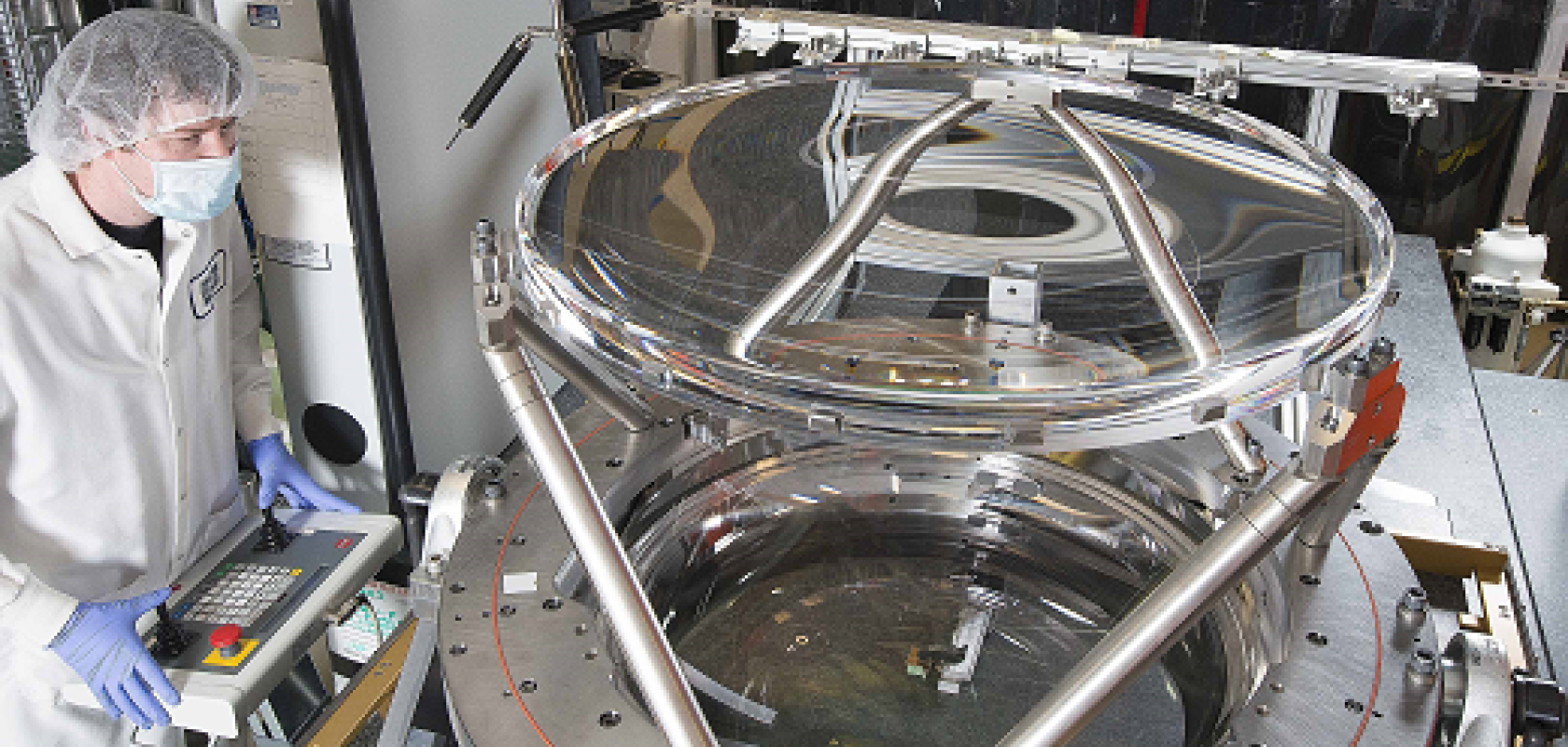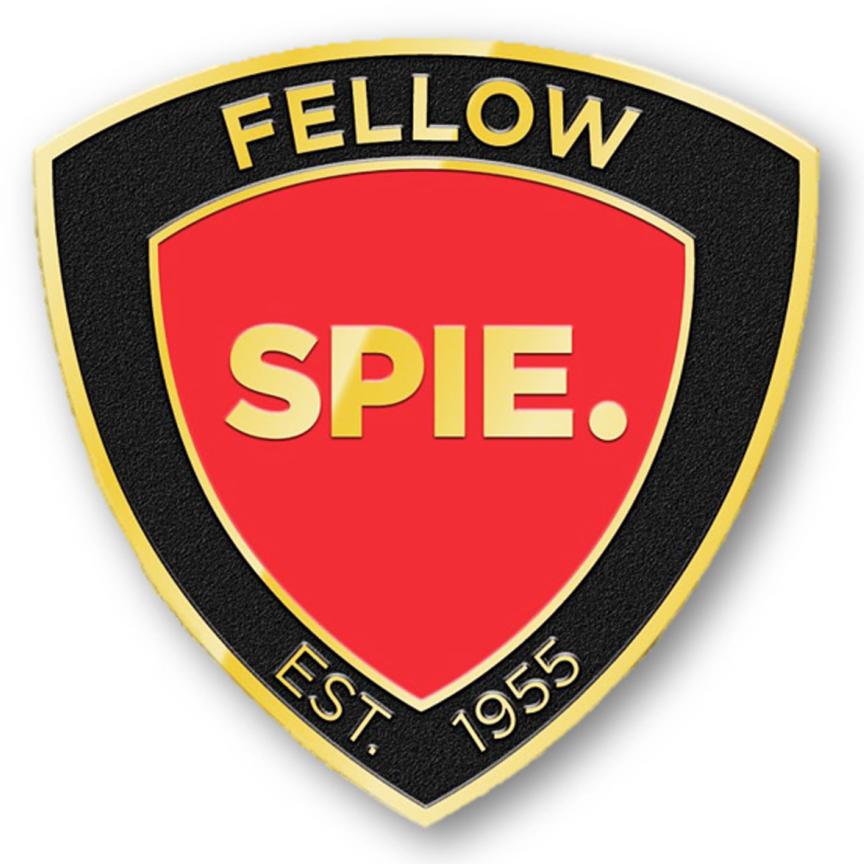The design of space-based telescopes has long been dictated by size, weight and power constraints associated with taking equipment off-planet – a rocket can only be so big, after all. This creates significant challenges when designing optical systems destined for space, which also need to offer best-in-class performances and withstand the harshest environmental conditions.
Size and weight can also be a factor for ground-based observatories, but in this area the challenges faced by optical designers lie more in having to counteract severe aberrations caused by the earth’s turbulent atmosphere.
Through the combination of properties offered by materials such as silicon carbide, the reduced optical system sizes enabled by freeform optics and the increasing number of actuators being used in adaptive optics systems, these challenges are being overcome to improve the performance of telescopes across the globe and those that are orbiting our planet.
New materials
The design of space-based optical systems is dictated by weight and volume constraints, which can also be a factor for ground-based observatories, depending on how the instruments are mounted, according to Mark Kahan, chief engineer of electro-optical systems at Synopsys’ Optical Solutions Group.
‘Optical design challenges for the main telescope assemblies centre on the need for larger entrance apertures (multi-metre) and higher resolution, with the minimum number of mirrors in a compact envelope,’ he explained. ‘This tends to push the mirror shapes to higher order aspheric surfaces, including freeform shapes, which puts higher demands on the optics fabricator.’
Environmental factors on Earth and in space also pose challenges, Kahan added: ‘Whether you are dealing with the extreme temperature variations that may be experienced on a mountain-top observatory, or the vibration profile of an instrument launched on a rocket, all of these factors need to be considered in terms of the material selection, packaging, alignment considerations, etcetera.’
In addressing these challenges, system designers and component manufacturers are turning to a combination of aspherical freeform optics and innovative materials in order to achieve maximum performance within tight size and weight constraints.
Silicon carbide is a material that has gained much interest for astronomical mirror optics, thanks to its unique combination of stiffness, weight and thermal stability, outperforming materials such as glass or beryllium used currently.
‘What you’re usually trying to achieve with telescope optics is high stiffness, light weight and temperature insensitivity,’ explained Michael Orr, product line manager for custom optics at Coherent, which produces optics for astronomy via its Tinsley business unit. ‘Beryllium is very stiff and very light; however, because it is a metal and therefore not very thermally stable, it expands and contracts significantly with changing temperature.’
On the other hand, glass – and also ceramics – are thermally stable, but have reduced stiffness. Stiff glass optics can be made, but they would then weigh more, Orr added.
‘Silicon carbide is a happy medium; it can be very stiff, not as stiff as beryllium, but much less thermally responsive. We are seeing increased interest in silicon carbide as a substrate for mirrors,’ Orr noted.
Widespread use of silicon carbide in the semiconductor industry has improved the supply chain and quality of available silicon carbide substrates.
‘The material has come a long way from where it started, in terms of lead time, size limits, and manufacturability,’ said Orr. ‘At Coherent, we have refined the polishing process so that we can now polish silicon-clad silicon carbide with the same surface accuracy as glass but much faster. With silicon carbide you can get custom optics with better stiffness/weight than glass, and shorter polishing times.’
Better substrate availability and mature polishing techniques have resulted in a growing interest in silicon carbide, with the material now being looked at in new ways, according to Orr. ‘Even certain components in ground-based telescopes are taking advantage of its unique combination of properties: stiffer than glass, very lightweight, and thermally insensitive,’ he said.
Freeform optics
As highlighted by Synopsys’ Kahan, an increasing number of astronomy customers are now turning to aspherical freeform optics with complex surface shapes to reduce inherent aberrations and increase the performance of their optical systems, while at the same time using fewer components to reduce weight and cost. This is particularly important for enhancing the viewing capability of space-based instruments on CubeSats and other small satellites, where the design envelope can be particularly constraining.
‘We are seeing keen interest in freeform optics in space-borne instruments involving scanning functions and other wide-field applications,’ noted Orr. ‘Here, optical distortions can cause a trade-off in the field of view and the image resolution. Freeform optics can significantly reduce this trade-off.’
Ongoing dialogue with Coherent’s customers is proving key to the increased use of freeform optics, Orr said, which can now use optical designs in a way that they haven’t been able to in the past. ‘Previously, they have been limited to having to use spheres or geometric aspheric shapes, which often meant more elements,’ he added. ‘Quite often, these solutions cannot achieve the results obtained with freeform surfaces.
Coherent uses robots to generate freeform surfaces, which enables the manufacture of the exact surfaces that its customers need. The figure and surface of the optics is then confirmed by metrology.
Coherent used its robotic polishing and metrology techniques to support the manufacturing of 600mm fused silica freeform lenses for the Javalambre Auxiliary Survey Telescope in Spain, which are currently being used to correct for the errors that arise with the telescope’s broad field of view as it maps out the night sky in high resolution.
Another application that’s driving the need for freeform optics is the search for exoplanets, Orr added.
‘Signal-to-noise is a major issue here, where the optical signals coming from an exoplanet can often be swamped by the bright star it is orbiting – by many orders of magnitude,’ he said. ‘One way that telescope designers are addressing this challenge is to develop optical designs that use freeform optics. Redirecting a lot of the star’s light away from the camera, enables the detection of dim light coming from the exoplanet.’
Responsive optics
The search for exoplanets is one of three major science drivers that were referenced in a recent successful proposal for funding from America’s National Science Foundation’s Major Research Instrumentation (MRI) programme, which will enable the WM Keck Observatory on Mauna Kea in Hawaii to upgrade the adaptive optics system of its 10-metre Keck II optical telescope.
Adaptive optics have become an essential tool in maximising the performance of earth-based astronomy. Using sensors that analyse the shape of light waves from either natural or artificial guide stars – the latter produced by focusing a set of lasers into the earth’s atmosphere – and sophisticated deformable computer-controlled mirrors, terrestrial telescopes can correct for the distortion caused by the turbulence of the Earth’s atmosphere in real time, enabling significantly sharper images.
‘How well an adaptive optics system corrects for turbulence in the earth’s atmosphere depends on many factors,’ said Dr Peter Wizinowich, chief of technical development at the WM Keck Observatory. ‘Two of these factors are measurement error and the time delay between the moment when a measurement of the turbulence is made and the moment when a compensating correction is applied to the deformable mirror.’
The recently approved upgrade to the Keck II adaptive optics system will implement a new wavefront sensor camera, which has less detector noise and can be read out faster to reduce the measurement error and the time delay, in addition to a real-time control computer, which will process the wavefront measurement considerably faster, further reducing the time delay.
The new upgrades, expected to be in place by the end of 2020, will also lay a foundation for future improvements, according to Wizinowich. ‘The new real-time controller will have the interface flexibility and computing capacity to be easily upgradeable,’ he explained. ‘One of the current limitations of laser guide star [LGS] adaptive optics is that a single LGS only samples a cone of atmosphere with its tip at the LGS, whereas the light from an astronomical object passes through a cylinder of atmosphere. [The observatory would like] to be able to use multiple LGS to sample this cylinder; this is known as laser tomography adaptive optics.’
Other improvements that could be facilitated by the upgraded platform, according to Wizinowich, include predictive wavefront control, sensor fusion, near-infrared wavefront sensing and higher order deformable mirror correction.
In the first half of 2018, another adaptive optics upgrade will take place on the four 1.8-metre auxiliary telescopes of the Very Large Telescope Interferometer (VLTI) at the Paranal Observatory in Chile, which are each to be augmented with a New Adaptive Optics Module for Interferometry (NAOMI) by the European Southern Observatory (ESO), which it claims will be like ‘putting the VLTI on steroids’.
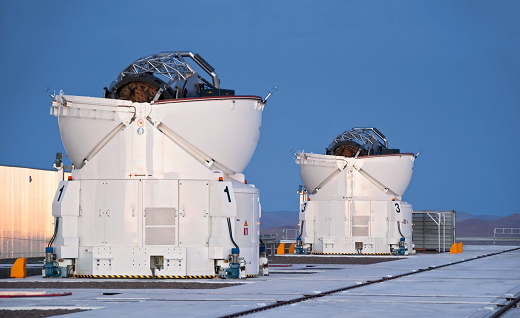
The 1.8m Auxiliary Telescopes of the VLTI at Paranal Observatory in Chile are each to be augmented with a ‘New Adaptive Optics Module for Interferometry’, or NAOMI by the European Southern Observatory (ESO) (Credit: ESO/D. Crabtree)
‘This long-awaited upgrade will allow the astronomers to reconstruct exquisite images of even fainter objects, like young pre-main sequence stars and their protoplanetary discs, post-main sequence mass-losing stars, and active galactic nuclei,’ explained Vincent Hardy, general manager of Alpao, the firm whose deformable mirror will act as the heart of the NAOMI system. ‘It will change shape about 500 times per second in order to actively counteract the damaging effect of wind and turbulence on the image quality.’
The VLTI Auxiliary Telescopes were originally equipped with STRAP (System for Tip/tilt Removal with Avalanche Photodiodes), a visible-light sensor that used a fast-steering mirror to correct the slight but rapid motion of the image of a star caused by atmospheric turbulence. While under good viewing conditions, STRAP provides sufficient aberration corrections, as soon as the conditions in the atmosphere degrade below one arcsecond; however, the quality of VLTI observations decay instantly. ‘With NAOMI, the observations will be able to continue even when the conditions are less than superb, and they will be better under all conditions,’ ESO said.
One of the recent advances in adaptive optics is the development of higher actuator count deformable mirrors with more control points – up to 8,000 – according to Michael Feinberg, VP of marketing and sales at Boston Micromachines, a manufacturer of deformable mirrors for adaptive optics systems, enabling them to correct for more complex optical aberrations and achieve higher-capability exoplanet images.
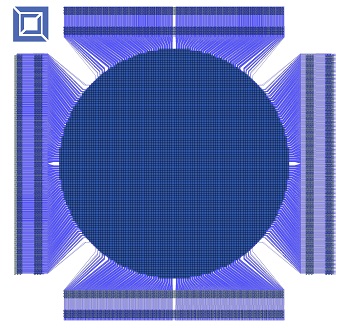
MEMS layout diagram of the 8K-DM (credit: Peter Ryan, Boston Micromachines)
‘Mirrors such as these are needed for the current extremely large telescopes that are currently under construction, and space telescopes scheduled to launch in the next 10 to 15 years for new-world space missions such as HabEx and LUVOIR [Large UV/Optical/IR Surveyor],’ said Feinberg.
LUVOIR is a conceptual multi-wavelength space observatory with the major goal of characterising a wide range of exoplanets. Boston Micromachine’s deformable mirrors, described by Feinberg to be suitable for both ground- and space-based systems, have been selected in a recent architecture and technology baseline description of LUVOIR, thanks to their high actuator count, and weight and size parameters.
Due to the lack of atmosphere in space, the deformable mirrors of space-based telescopes require much less application speed than ground-based telescopes – which themselves require speeds upwards of 1kHz – to correct for the much slower-moving aberrations. Boston Micromachines is currently developing systems that use half the power, yet match the capability of its current devices, which will be ideal for space-borne adaptive optics systems where power requirements are much stricter.
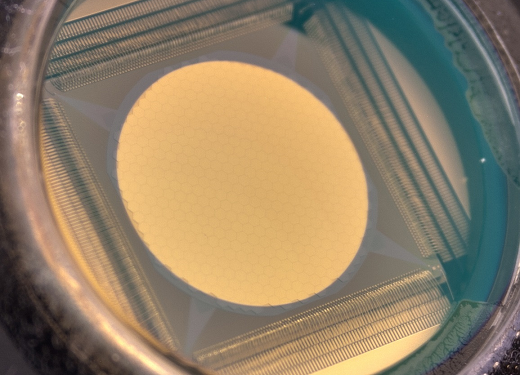
A close-up view of Boston Micromachines’ Hex-1011 deformable mirror (credit: Boston Micromachines)
Collaboration is key
While adaptive optics is and will be an increasingly important element of modern astronomy, the technology currently has limited application elsewhere, which can affect the securing of further funding, such as that obtained by the WM Keck observatory from the NSF MRI programme.
‘Considering the limited market for astronomical adaptive optics, development is always an issue, as it is hard to justify development for just a few customers needing one-of-a-kind equipment,’ confirmed Feinberg. ‘So this is where government funding is instrumental in making sure that our technology meets the needs of the next generation of telescopes.’
However, according to Wizinowich, of the WM Keck Observatory, the availability of funding in the US has been a primary challenge in the further development of adaptive optics for astronomy. ‘The field is better funded in Europe thanks to ESO and European-wide initiatives,’ he said. ‘International competition has been more in the nature of international collaboration, however, which has helped the field to grow.’
In addition, collaborations between astronomy and other photonics sectors are also valuable for the further development of adaptive optics. ‘This has often taken the form of the astronomical community working with industry to develop the needed products, and is based on existing strengths of the particular company,’ Wizinowich explained. ‘For example, the development of a sodium wavelength laser for laser guide star adaptive optics by Toptica Photonics and MPB Communications was prompted and funded by ESO and the WM Keck Observatory; the resultant laser has been a huge improvement over previous lasers. Other examples include detectors and cameras for wavefront sensing, deformable mirrors and computing technology.’
Toptica Photonics’ 589nm SodiumStar guide star laser was produced in partnership with MPB Communications and is currently installed at both the WM Keck Observatory in Hawaii and the VLT in Chile. ESO also recently signed a new agreement for the production of four more SodiumStar systems for the adaptive optics of the upcoming European Extremely Large Telescope, which is currently set for first light in 2024.
A further technology the astronomy field could borrow from the photonics sector is the development of both curved and highly sensitive sensors, according to Kahan, of Synopsys, which would enable systems with a wider field of view and fewer optical components, as well as systems capable of registering more photons in less time, in order to see fainter objects.

